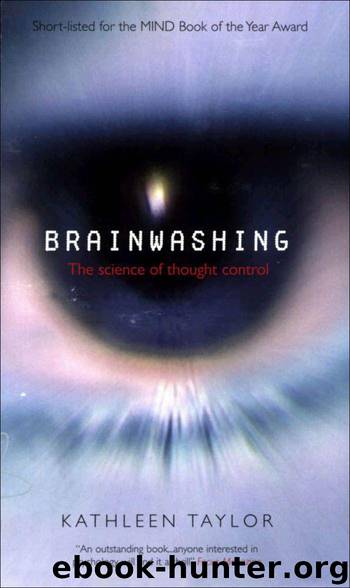Brainwashing: The science of thought control by Kathleen Taylor

Author:Kathleen Taylor [Taylor, Kathleen]
Language: eng
Format: mobi
Tags: The Science of Thought Control
Publisher: Oxford University Press
Published: 2004-11-24T14:00:00+00:00
Figure 10.1 A human brain, schematically rendered. (a) Lateral (outer) view, showing approximate location of the PFC. (b) Medial (inner) view, showing approximate location of the anterior cingulate cortex.
The anterior cingulate receives input from, and sends signals to, many of the emotion-processing areas of subcortex discussed in Chapter 9, such as the amygdala, periaqueductal grey (PAG), and hypothalamus. Hence the cingulate has a short chain of command to the nerves and hormones which give the human body its powers of response and expression. These powers, while sometimes regulated by conscious control, often seem disconcertingly able to escape it, as any sufferer from panic attacks can testify. Bodily symptoms can also be strongly motivational—pain is an obvious example—providing a powerful impetus to action. The cingulate seems to serve as a bridge between subcortical areas processing this drive and the PFC. Using the Marxist metaphor from Chapter 9, it channels power from base to superstructure and control from superstructure to base.
The PFC’s role has been described in many ways. It appears to be involved in ordering, structuring, and guiding behaviour, particularly in challenging or novel situations. It is thought to mediate choosing between alternative options, interpreting possibilities, and modelling potential futures. The urge to thump your boss may from time to time be extremely tempting, but you also want to stay in work. A well-trained PFC will save your career, forcing you to stop and think before you swing that punch. This ability to stop and think, so essential for a civilized existence, seems to require an intact prefrontal lobe. Stop-and-think also allows us to resist influence attempts. Any would-be brainwasher seeking to practise mindcraft on a victim must first get past that victim’s prefrontal guard.
The PFC’s importance is reflected by what happens when it fails to function properly. Damage to prefrontal areas does not result in clearly observable problems in the way that, say, damage to the visual cortex results in blindness. A patient with prefrontal damage can perform well on standard tests of brain function. Phineas Gage, part of whose PFC was damaged by a workplace accident (see note 16, on lobotomy, in Chapter 1), remained conscious and rational: the doctor who first examined him was able to ask him what had happened. However, as his doctor was later to observe, ‘Gage was no longer Gage.’ As described by Antonio Damasio in Descartes’ Error, before his injury Gage ‘had a sense of personal and social responsibility […] was well adapted in terms of social convention and appears to have been ethical in his dealings. After the accident, he no longer showed respect for social convention; ethics, in the broad sense of the term, were violated; the decisions he made did not take into account his best interest, and he was given to invent tales […] There was no evidence of concern about his future, no sign of forethought.’
Like brainwashing, PFC damage changes the personality, generally for the worse and without the victim’s realizing. Depending on which area is damaged, the effects can be extremely variable.
Download
This site does not store any files on its server. We only index and link to content provided by other sites. Please contact the content providers to delete copyright contents if any and email us, we'll remove relevant links or contents immediately.
| Administration & Medicine Economics | Allied Health Professions |
| Basic Sciences | Dentistry |
| History | Medical Informatics |
| Medicine | Nursing |
| Pharmacology | Psychology |
| Research | Veterinary Medicine |
Periodization Training for Sports by Tudor Bompa(8096)
Why We Sleep: Unlocking the Power of Sleep and Dreams by Matthew Walker(6556)
Paper Towns by Green John(5022)
The Immortal Life of Henrietta Lacks by Rebecca Skloot(4447)
The Sports Rules Book by Human Kinetics(4213)
Dynamic Alignment Through Imagery by Eric Franklin(4050)
ACSM's Complete Guide to Fitness & Health by ACSM(3937)
Kaplan MCAT Organic Chemistry Review: Created for MCAT 2015 (Kaplan Test Prep) by Kaplan(3906)
Introduction to Kinesiology by Shirl J. Hoffman(3699)
Livewired by David Eagleman(3623)
The River of Consciousness by Oliver Sacks(3498)
The Death of the Heart by Elizabeth Bowen(3483)
Alchemy and Alchemists by C. J. S. Thompson(3422)
Bad Pharma by Ben Goldacre(3208)
Descartes' Error by Antonio Damasio(3188)
The Emperor of All Maladies: A Biography of Cancer by Siddhartha Mukherjee(3025)
The Gene: An Intimate History by Siddhartha Mukherjee(3014)
The Fate of Rome: Climate, Disease, and the End of an Empire (The Princeton History of the Ancient World) by Kyle Harper(2975)
Kaplan MCAT Behavioral Sciences Review: Created for MCAT 2015 (Kaplan Test Prep) by Kaplan(2903)
